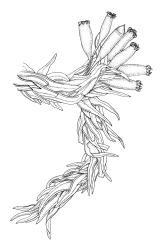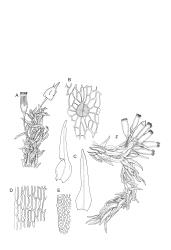- ≡ Orthotrichum parvithecum R.Br.bis, Trans. & Proc. New Zealand Inst. 27: 440 (1895)
- = Orthotrichum beckettii R.Br.bis, Trans. & Proc. New Zealand Inst. 35: 333 (1903) nom. illeg., non Orthotrichum beckettii Müll.Hal. 1898
Setae short, 1–3.5(–4.0) mm (excluding vaginula), not exposed or exposed for ≤2 mm beyond the perichaetial leaves (best seen when moist); capsules usually 2–5 (occasionally 1) per perichaetium, cylindric-ovoid, immersed, emergent, or short-exserted, usually smooth throughout when dry, often persisting for several seasons, 1.0–1.5 mm.
When well-developed, the var. parvithecum is distinctive in terms of sporophyte morphology and number, and it favours areas of higher rainfall than the var. tasmanicum. Lewinsky (1984, p. 414) noted no differences between the gametophytes of the two varieties (excepting a perceived weak tendency to larger, looser tufts in var. parvithecum). She also suggested that the sporophyte morphology and number might be influenced by environmental factors over time, even on the same shoot. Lewinsky (1984, p. 387–393) discussed variation in size and number of sporophytes and the number of archegonia per perichaetium of O. tasmanicum s.l., noting that their respective numbers and size varied from year to year within single populations. The morphological distinctions between the var. tasmanicum and var. parvithecum are thus not clear-cut and many collections of O. tasmanicum s.l. cannot be named confidently to varietal level. Occasionally material is seen illustrating a wide range of sporophyte number, setae lengths, and capsule ribbing (e.g., J.K. Bartlett 17683 from Lake Cobb, Nelson L.D., WELT M008460). Also perplexing are specimens with multiple capsules that are large (c. 2.0 mm) and not ribbed when dry (e.g., W. Martin 323.18 from Franz Josef Glacier, WELT M004646). While the variation within O. tasmanicum s.l. is intractable, Lewinsky’s segregation of the variety parvithecum is adopted as the most practical available solution.
The cylindric-ovoid capsules, the usually longer (mostly 1–3.5 mm) setae and the bands of thick-walled exothecial cells of O. tasmanicum var. parvithecum distinguish it from the often associated O. graphiomitrium, which has shorter and fatter capsules, shorter setae (c. 1 mm), and lacks bands of thick-walled exothecial cells.
NI: S Auckland (near Te Whāiti, Maunga Pōhatu, Ōpepe, Tauhara), Gisborne (L. Waikaremoana), Hawke’s Bay (Tūrangakumu Hill), Taranaki (Pouākai Range, Mt Taranaki), Wellington (Ketetahi Track, near Tangiwai; SI: Nelson (Lake Cobb), Canterbury (Arthur’s Pass, Bealey, Mt Thomas, Banks Peninsula), Westland (Ōtira Gorge, Kelly Range, Hōhonu Range, Adams Range, Franz Josef), Otago (Mt Cargill, Leith Valley), Southland (Te Ānau, near Homer Tunnel, Gertrude Valley); St.
Endemic. Unknown from north of 38°S on the North I.
An epiphyte that is particularly common on Hoheria spp., and is restricted to areas with high rainfall. In addition to the seven native genera recorded as hosts by Lewinsky (1984, tab. 1), O. tasmanicum var. parvithecum occurs on Carpodetus and the adventive genera Larix, Populus, and Salix. Usually associated with Calyptopogon mnioides; often with O. calvum, O. graphiomitrium, Ulota lutea, and Metzgeria "flavovirescens".
Orthotrichum tasmanicum var. parvithecum was treated as O. beckettii Müll.Hal. by Dixon (1926, p. 176), while Sainsbury (1955, p. 209) considered O. beckettii Müll.Hal. to be inseparable from his concept of O. tasmanicum because of the large number of intermediate specimens. The status of O. beckettii Müll.Hal. was discussed at length by Lewinsky (1984, p. 414); she considered it best treated within her concept of O. tasmanicum var. tasmanicum. Lewinsky resurrected the neglected but less ambiguous name O. parvithecum R.Br.bis to serve as the basionym of a new combination at the varietal level.
The later name O. beckettii R.Br.bis., Trans. & Proc. New Zealand Inst. 35: 333 (1903), is an hom. illeg. non O. beckettii Müll.Hal., 1898] and was placed by Lewinsky as a taxonomic synonym of O. tasmanicum var. parvithecum.





